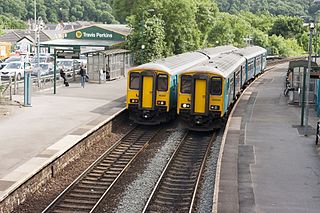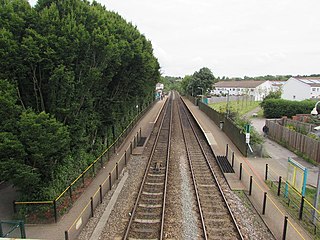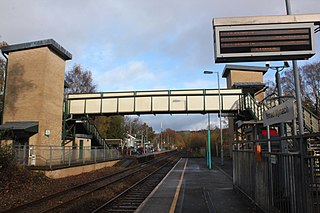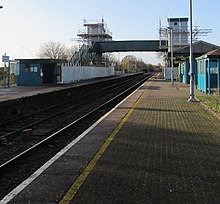Valleys &Cardiff Local Routes is the network of passenger suburban railway services radiating from Cardiff,Wales. It includes lines within the city itself,the Vale of Glamorgan and the South Wales Valleys.

The Taff Vale Railway (TVR) was a standard gauge railway in South Wales,built by the Taff Vale Railway Company to serve the iron and coal industries around Merthyr Tydfil and to connect them with docks in Cardiff. It was opened in stages in 1840 and 1841.
The Rhymney Railway (RR) was a railway company in South Wales,founded to transport minerals and materials to and from collieries and ironworks in the Rhymney Valley of South Wales,and to docks in Cardiff. It opened a main line in 1858,and a limited passenger service was operated in addition.

The Vale of Glamorgan Line is a commuter railway line in Wales,running through the Vale of Glamorgan from Barry to Bridgend,via Rhoose and Llantwit Major.

Grangetown railway station is a railway station serving the Grangetown district of Cardiff,Wales. It is located on the Vale of Glamorgan Line 1 mile (1.5 km) south west of Cardiff Central towards Bridgend via Barry,Penarth and Barry Island.

Cogan railway station is a railway station serving Cogan in the Vale of Glamorgan,Wales. It is on the Vale of Glamorgan Line 2+3⁄4 miles (4.4 km) south of Cardiff Central on the way to Barry Island and Bridgend.

Barry Island railway station is a railway station,9+1⁄4 miles (14.9 km) south-west of Cardiff Central,serving Barry Island in South Wales. The station has been the terminus –and only remaining active station at the end of the Barry branch of the Cardiff Central to Barry Island line since the closure of Barry Pier station in 1976,the last passenger working through Barry Island tunnel to the Pier station being an enthusiasts' special in 1973. Previous to that year,only a few revenue-earning workings to meet up with the former P&A Campbell's paddle-steamer trips to Weston-super-Mare or other Somerset/Devon havens,were made following May 1964.

Barry railway station is one of three stations serving the town of Barry,Vale of Glamorgan in South Wales. This one,Barry Town,is preceded by Barry Docks and Cadoxton stations on the Barry Branch which runs from Cardiff Central to a fourth station at Barry Island,the terminus. Barry is also the junction at the start of the Vale of Glamorgan Line which serves Rhoose and Llantwit Major and terminates at Bridgend.

Radyr railway station is a railway station serving the Radyr area of Cardiff,South Wales. It is at the foot of the hill at the eastern edge of the village,alongside the River Taff and adjacent to the Taff Trail. The station is on the Merthyr Line,and is also the northern terminus of the City Line.

Taffs Well railway station is a railway station serving the village of Taff's Well,Rhondda Cynon Taf,Wales,as well as neighbouring Gwaelod-y-Garth,Cardiff. It is located on the Merthyr Line and the Rhondda Line. Passenger services are provided by Transport for Wales.

Pengam railway station is situated in Pengam on the Rhymney Line of the Valley Lines network in South Wales. It is also the nearest station to the town of Blackwood and is the 2nd busiest station on the Rhymney Line,after Caerphilly.

Eastbrook railway station is a railway station serving the Eastbrook area of Dinas Powys,a village near Cardiff,South Wales. It is located on Network Rail's Barry Branch 3+1⁄2 miles (5.6 km) south of Cardiff Central towards Barry Island and Bridgend.

Dinas Powys railway station is one of two railway stations serving the village of Dinas Powys in the Vale of Glamorgan,South Wales. It is located on Network Rail's Barry Branch 4½ miles (7 km) south of Cardiff Central towards Barry Island and Bridgend.

Ystrad Mynach railway station is a railway station serving the town of Ystrad Mynach,south Wales. It is a stop on the Rhymney Line of the Valley Lines network.

Aber railway station is a railway station serving the town of Caerphilly,south Wales. It is a stop on the Rhymney Line 8+1⁄4 miles (13.3 km) north of Cardiff Central on the Valley Lines network.

Caerphilly railway station is a railway station serving the town of Caerphilly,south Wales. It is a stop on the Rhymney Line of the Valley Lines network. The station is located at Station Road in the south of the town. Facilities include a small shop and a ticket kiosk. A self-service ticket machine was installed near the entrance to the station on 22 December 2008. Several advertising murals depicting holiday travel in various parts of South Wales have been placed on the northbound side of the station in order to improve the 'look' of the station.

The Barry Railway Company was a railway and docks company in South Wales,first incorporated as the Barry Dock and Railway Company in 1884. It arose out of frustration among Rhondda coal owners at congestion and high charges at Cardiff Docks as well the monopoly held by the Taff Vale Railway in transporting coal from the Rhondda. In addition,the Taff Vale did not have the required capacity for the mineral traffic using the route,leading to lengthy delays in getting to Cardiff.
Rail transport in Cardiff has developed to provide connections to many other major cities in the United Kingdom,and to provide an urban rail network for the city and its commuter towns in southeast Wales. Today,there are three train operating companies in Cardiff:Great Western Railway,CrossCountry and Transport for Wales.

Walnut Tree Viaduct was a railway viaduct located above the southern edge of the village of Taffs Well,South Wales. Originally built to carry the Barry Railway across a narrow gorge through which the River Taff,Taff Vale Railway and Cardiff Railway passed,it was deconstructed in 1969,leaving only two of the support columns visible from the A470 road.

Wenvoe Tunnel is a disused tunnel on the defunct Barry Railway that runs under Culverhouse Cross in the Vale of Glamorgan in south Wales,on the western outskirts of Cardiff. It was opened in 1889 on a line used to carry coal to Barry Docks. The line also had a sparse passenger service and closed after March 1963.


















